
History of IT at Sussex
In the academic year 2011-2012, the University celebrates its 50th anniversary. Over the course of the last fifty years, computing at Sussex has developed from a highly specialised niche to become a vital component of University life, for both students and staff alike.
Widening participation
In 1961, computer users required a great deal of expertise and determination, compiling programs on punched cards which were then taken by road or rail to facilities where computers were located.
The development of the technology has grown from expert scientific or engineering applications to encompass all subjects with computing skills now essential for every student and member of staff.
Computing at Sussex in 2011
Computing services are now available around the clock and web-based research and word-processing skills have become essential for all students. Audio-visual technology has become a standard feature in all new teaching rooms, along with the ability to capture or broadcast lectures and seminars. The University engages in social networks, shares knowledge and collaborates instantly with colleagues around the world.
Computing has become part of the standard furniture of University life at Sussex. The five decades have witnessed its transformation from a highly specialised niche interest into a service unthinkable to live without. The availability of wi-fi has brought mobile and instant access to almost limitless global data. Students hold in their hands tiny devices many times more powerful than the room-sized machine with which the history of computing at Sussex once began.
The Shawcross Data Centre
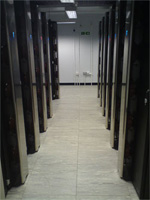
In late 2010, the new data centre in Shawcross came into operation as the primary server room on the campus.
Constructed to a high specification, the new complex incorporates an uninterruptible power supply and is capable of running independently on its own generator power. Featuring energy-efficient technologies such as water-cooling, the design will help the University to achieve environmental targets whilst providing security, availability and connectivity for high-performance computer equipment.
Construction of the data centre required major internal amendments within the listed shell, and was completed to budget and on schedule.
During the development, floor levels were altered, a section of land adjacent to Shawcross was cleared and levelled to make way for cooling units and supply tanks and a six-tonne generator was delicately manoeuvred into position.
The design of the new facility brings IT at Sussex right up to date, featuring some of the latest innovations in the industry:
Water cooling
Server racks are cooled with integral water channels, which is more effective than air-cooling. The room can be operated at a warmer temperature, helping us to achieve an excellent environmental profile.
Particle detection
Sensors sited throughout the server room detect particle densities indicative of a fire.
Gas suppression
The automatic suppression facility will flood the room with flame-retardant gas if thresholds are exceeded in multiple adjacent sectors.
Timeline
1963
Electro-mechanical machines were used to create programs on punched cards. These were dispatched and fed onto computers at offsite locations. The University recruited staff to carry boxes of punched cards by train to the Atlas Computer Laboratory near Oxford.
1966
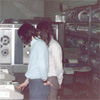
The University acquired an on-site ICL (International Computers Limited) computer that occupied an entire room. The device was run from early morning through to late evening by a team of operators working in shifts. Users could submit their program cards and expect to receive the results in a matter of hours. Having a computer on site was a major advance, yet highly frustrating for early users. Errors as minor as a single misplaced comma were sufficient to cause an entire program to fail.
1970
A new programming group was introduced within the Faculty of Arts. This translated the requirements of researchers and students into program code. Facilities became available across the Humanities and Social Sciences, enabling researchers to analyse large volumes of statistical data. These required all of the University computer’s resources, so would be set to run overnight.
1973
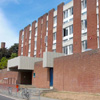
Computing was becoming an integral feature of University life. Dick Grimsdale, who as a research student built the world's first fully transistorised computer, worked at Sussex for most of his career. It was during his conference in 1973 that the first transatlantic email was sent. It was sent from the Richmond building, to recipients in the United States.
1980
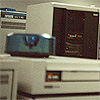
The University invested in more powerful VAX 'minicomputers'. These occupied wardrobe-sized cabinets within the Computing Centre. These new machines were programmed using workstations with a keyboard and monitor. This enabled staff to type in their own program code. Professional programmers were no longer needed. IT became far more accessible to users, many of whom could apply skills learned in the home-computing boom.
Late 1980s
The first computer rooms were set up and it became possible for students without any technical knowledge to use them. Although regarded as a waste of resources by many, word-processing gradually began to replace typewriters. Electronic communication began to be used as an alternative to paper correspondence. Anyone able to follow a forty-page manual could now send e-mails!
Early 1990s
The campus-wide network was completed in the early 1990s, followed by a whole new suite of PCs. Hundreds registered with the new system. An early contribution to improving the employability of students were the Computer and Information Handling courses which were offered at evenings and weekends. Employers were increasingly looking for technical skills in new graduates. These courses helped to equip students with the ability and confidence to use computers effectively.
1996
A series of projects were launched to make information available electronically to colleagues and students. Even before search engines and web browsers, resources were published electronically and made available to recipients at the University and beyond. The University was quick to embrace the possibilities of the World Wide Web. This led to the launch of the first University-wide, public website in late 1996.
Gallery
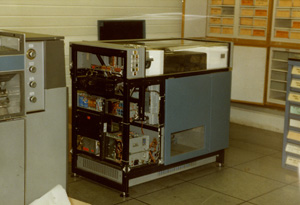
ICL printer, 1970s
The University's first computer had its own printer which produced the output generated by programs. Staff spent a lot of their time making sure that reports were printed correctly.
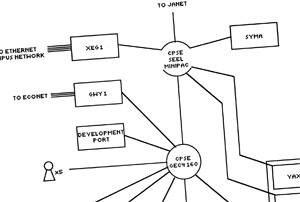
Network diagram, 1989
A campus-wide network was completed in the early 1990s, enabling desktop computers to be deployed in offices and cluster rooms.
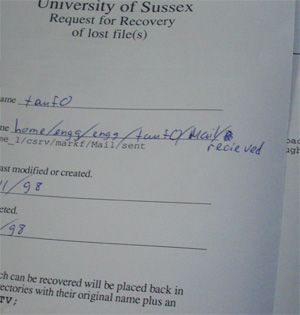
Request for data to be recovered, 1998
Before email was widely available, requests for services such as the recovery of lost data were submitted on paper forms.
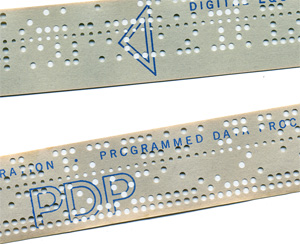
Paper tape
As well as punched cards, paper tape was sometimes used to store programs.
Stories
The staff fund
Before the 1980s, the growing demand for computing required hundreds of thousands of printed cards, each of which could only be used once.
Rather than dispose of them, Computing Centre staff arranged for the prodigious volumes to be recycled instead, receiving a small fee for each consignment.
The payments went into a fund which was used to buy useful things like a sewing machine or automotive tools which staff could borrow when required.
Driving lessons
Before the University purchased its own computer, it was possible to write programs by punching cards on the premises and then sending them to facilities where there were computers.
This often meant staff were required to carry boxes of cards on the train to the ATLAS laboratory at Chilton which had a powerful computer used by researchers all over the UK. In reaction to the growing demand at Sussex, the University even funded driving lessons for staff, enabling them to take larger quantities by road.
People
Dave Newell
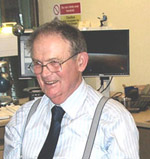
The longest-serving member of IT Services, Dave arrived at Sussex as a student in 1962. Soon after graduation, he joined the staff as a programmer and in a long career, witnessed at first hand the dramatic changes in computing. He retired in 2010.
Updated on 3 February 2012